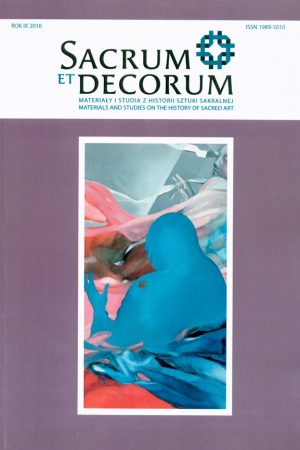Zwiastowania Marzanny Wróblewskiej. Z malarskiego dziennika artystki
Słowa kluczowe:
Marzanna Wróblewska; zwiastowanie; pejzażAbstrakt
Marzanna Wróblewska to współczesna polska artystka, w której twórczości dominuje malarstwo o tematyce pejzażowej oraz realizacje sakralne. Namalowany w latach 80. minionego wieku cykl Zwiastowanie można uznać za zapis przełomu, jaki dokonał się w psychice malarki. Początkowo Wróblewska przedstawiała przede wszystkim postać ludzką, najczęściej akt kobiecy zamknięty we wnętrzu. Jej obrazy cechowało nagromadzenie negatywnych emocji skoncentrowanych wokół fizyczności kobiecego ciała. W typowym dla tego wczesnego okresu cyklu obrazów Apercepcje artystka wprowadzała elementy podkreślające zamknięcie przestrzeni wokół samotnej nagiej postaci kobiecej. Dopiero wraz z cyklem Zwiastowań przestrzeń w twórczości Wróblewskiej zaczyna się otwierać, a artystka stopniowo odkrywa język świata przyrody prowadzący ją od figuracji do abstrakcji, od sensualizmu i egzystencjalnych dramatów do doznań metafizycznych i przeżycia sacrum. Zestawione ze sobą Zwiastowania przez konsekwencję kompozycyjnego rytmu sprawiają wrażenie różnych sekwencji wędrówki postaci poruszającej się w zmieniającym się umownym pejzażu. Cykl można uznać za próbę odtworzenia następujących po sobie emocji, jakich doznawała Maria z Nazaretu wobec słów wypowiedzianych przez anioła. Artystka ujmowała te doznania w formie wizualnej, wykorzystując elementy pejzażu i budując w ten sposób metaforę drogi jako odpowiednika procesu zachodzącego w psychice Madonny. Można uznać, że następujące po sobie obrazy cyklu ukazują także kolejne etapy wędrówki malarki odkrywającej nowy świat doznań. Postać Marii na obrazach Wróblewskiej skrywa także w pewnej mierze samą artystkę i jej własną przemianę, dojrzewanie do zmiany perspektywy widzenia własnego życia i jego celu.Downloads
Pobrania
Opublikowane
Jak cytować
Numer
Dział
Licencja
Prawa autorskie (c) 2016 Sacrum et Decorum

Utwór dostępny jest na licencji Creative Commons Uznanie autorstwa – Użycie niekomercyjne – Bez utworów zależnych 4.0 Międzynarodowe.
Zgodnie z polityką Open Access autorzy zachowują pełnię praw autorskich do swoich artykułów – bez ograniczeń.
Autorzy mogą deponować swoje artykuły w wybranym przez siebie repozytorium.


